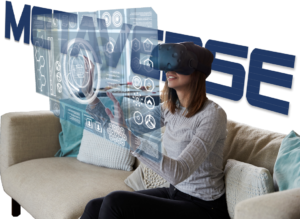According to tech futurist and metaverse expert Cathy Hackl (@CathyHackl), “No official definition yet exists for the metaverse, but companies can’t afford to wait until one does or the metaverse fully evolves to start experimenting and investing in it.”[1] She adds, “If you wait a year-and-a-half or two-years to do something, to have a clear strategy, and to start testing these assumptions, it might be a little bit too late.” Although that may sound like she’s suggesting companies enter the metaverse wearing blinders, I think she’s suggesting they should enter the metaverse wearing virtual reality (VR) goggles. Oliver Wright (@owright001), a Managing Director at Accenture, writes, “There’s a lot of excitement about the metaverse — and for good reason. By allowing consumers to seamlessly move between two different realities, the metaverse is already creating countless new opportunities for retailers and consumer brands.”[2] Although the metaverse is primarily known as a realm for gaming, retailers and brands need to be dead serious about entering this space.
Why Retailers Must Take the Metaverse Seriously
“While commercial applications are still in their early stages,” Wright explains, “the metaverse is set to transform how retailers and brands interact with consumers.” Despite such predictions, there remain skeptics. Mike Proulx (@McProulx), a Vice President and Research Director at Forrester Research, believes most of the skepticism involves having to wear virtual reality goggles. He explains, “For those that say, ‘The metaverse is going to fail, because who’s going to want to wear a VR headset for hours at a time?’ … technology is going to continue to advance and evolve so that we’re not going to be in a state — in time — where we’re going to have clunky headsets. They will become much more accessible and much less intrusive to our faces.”[3] He also points out that virtual reality isn’t the only way to enter the metaverse. Augmented reality (AR) is also poised to play a big role. He continues, “Other entry points are things like augmented reality, really any extended reality experience. We also believe that the metaverse is bi-directional — that over time while you will be able to enter the immersive spaces, so will the metaverse be able to enter your physical spaces through things like holographic projections.”
Because experiences in the metaverse will attract consumers, Proulx insists retailers and brands can’t risk not having a presence in it. “If we were to project out the shopping experience into the future, as the metaverse becomes actualized,” he states, “one could imagine a much more personalized and truly seamless type of shopping experience.” The greater risk, he believes, is trying to extrapolate traditional shopping techniques into the metaverse. He explains, “We’re in danger of taking how we shop today and applying those concepts into the metaverse.” However, he predicts, “The way we do shopping in the physical world … is going to be different in a metaverse.” Because we don’t know how metaverse shopping will be different, Hackl recommends retailers and brands continue to experiment. Proulx agrees. He states, “The risk is low [in experimenting]. Right now, in the context of the metaverse … as long as brands temper their expectations and temper their investments, and are going in with truly an experimentation mindset, then they really don’t have a ton of risk.”
Not only does experimenting in the metaverse come with little downside, it holds enormous upside potential. R “Ray” Wang, principal analyst, founder, and chairman of Constellation Research, writes, “Much has been made about the metaverse, but few organizations have fully grasped the impact it will have on experiences and engagement inside the enterprise. More than just gaming worlds or hardware devices, the metaverse economy brings new opportunities for enterprises to bring their physical presence and 3-D digital presences together in one unified offering to their stakeholders — customers, employees, partners, and suppliers.”[4] His company predicts the metaverse will be part of a $21.7 trillion market by 2030. Retailers and brands cannot afford to ignore that kind of market.
Where is the Retail Metaverse Heading?
Ryan Mullins (@rdavidmullins), CEO and co-founder of Aglet, predicts, “The future of the internet is spatial. Hence, ‘the metaverse’ as virtual worlds are about an avatar’s movement within a designed environment. Augmented reality experiences are about a person’s physical movement in and around the world. … We’re on the cusp of massive changes in commerce because the core interface of the internet will change. Identity, payments, media, social, commerce and governance will change drastically as a result of this fundamental design change.”[5] He adds, “For retail in particular, I do think that the meaning of a ‘store’ will change dramatically. I think it’s possible to leverage much of this mobilization to drive social experiences in physical meetups at stores.”
The metaverse is poised to be more than a space in which consumers experience things. It will also be a space in which consumers can find information. A recent survey conducted in the United Kingdom by Akeneo found, “Almost two-fifths of UK consumers now want to use augmented reality and the metaverse to find product information as part of their buying journey.”[6] Fred de Gombert (@FdeGombert), CEO at Akeneo, states, “The way we shop is rapidly changing and it’s essential to understand not only how and where consumers are engaging with your products, but what their expectations are for your brand. The product experience that you design for your various online channels must first be consistent and second be continued through all the points where your consumers will be making their purchases and returns, be they digital or physical.”
Concluding Thoughts
Although Hackl and Proulx insist risks associated with metaverse experimentation are small, they are not negligible. Journalist Sara Karlovitch (@Sara_Karlo7) explains, “As brands seek to stake a claim in the metaverse, marketers must know the risks and lingering issues associated with the emerging space. Issues of safety and inclusivity cannot be overlooked.”[7] Tiffany Xingyu Wang (@tiffanyxingyuw), Co-founder and President of the Oasis Consortium, explained to Karlovitch that all the negative aspects of the current internet will be amplified in the metaverse. She explains:
“The past 15-20 years really led us to what I call the loss of trust in Web2, as over 40% of U.S. internet users have said to be harassed or subjected to hate speech online. There’s the safety issue, which is mainly because we didn’t have safety guardrails from the get-go in Web2. We have a data issue, the privacy issue. Every 39 seconds, there’s a data breach. And then we have the inclusion issue. Today, facial recognition AI recognizes the wide scheme, the males 34% better than dark-skinned females in many circumstances. We’re talking about an era where we don’t have safety, privacy and inclusion. Those aspects are completely amplified in Web3. The immersiveness basically amplified exposure, because it’s immersive, you feel more, the impact is more major. Persistence really drives the velocity of toxicity because it’s persistent all the time.”
As a result, Wang insists brands should be cautious as they enter the metaverse and they should “address the safety issues right now. … We are putting the brands adjacent to potential hate speech and racism issues, which will cause problems.” As Facebook and Twitter can attest, dealing with hate speech, harassment, and misinformation is not easy. Retailers may not like having to deal with such issues; however, ignoring the metaverse is not likely possible for retailers in the years ahead.
Footnotes
[1] Staff, “What is the metaverse—and what does it mean for business?” McKinsey Digital, 29 March 2022.
[2] Oliver Wright, “Brands, Get Ready To Meet Your Consumers In The Metaverse,” The Marketing Insider, 6 May 2022.
[3] Mike Proulx, “Tech Transformation Podcast: Forrester Shares the (Real) Future of the Metaverse for Retail,” Consumer Goods Technology, 4 May 2022.
[4] R “Ray” Wang, “Understanding the Metaverse Economy,” Destination CRM, 11 April 2022.
[5] Jacqueline Barba, “Q&A: Metaverse, Gamification & the Next Era of Commerce,” Path to Purchase IQ, 5 May 2022.
[6] Paul Skeldon, “The retail Metaverse prompts growing digital demands for product information,” Internet Retailing, 13 April 2022.
[7] Sara Karlovitch, “What marketers should consider when it comes metaverse brand safety,” Marketing Dive, 26 April 2022.





